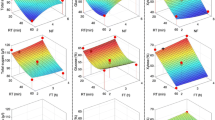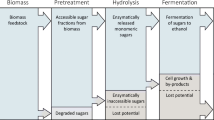Abstract
Experimental results are presented for continuous conversion of pretreated hardwood flour to ethanol. A simultaneous saccharification and fermentation (SSF) system comprised ofTrichoderma reesei cellulase supplemented with additional β-glucosidase and fermentation bySaccharomyces cerevisiae was used for most experiments, with data also presented for a direct microbial conversion (DMC) system comprised ofClostridium thermocellum. Using a batch SSF system, dilute acid pretreatment of mixed hardwood at short residence time(10 s, 220°C, 1% H2SO4) was compared to poplar wood pretreated at longer residence time (20 min, 160°C, 0.45% H2SO4). The short residence time pretreatment resulted in a somewhat (10–20%) more reactive substrate, with the reactivity difference particularly notable at low enzyme loadings and/or low agitation. Based on a preliminary screening, inhibition of SSF by byproducts of short residence time pretreatment was measurable, but minor. Both SSF and DMC were carried out successfully in well-mixed continuous systems, with steady-state data obtained at residence times of 0.58–3 d for SSF as well as 0.5 and 0.75 d for DMC. The SSF system achieved substrate conversions varying from 31% at a 0.58-d residence time to 86% at a 2-d residence time. At comparable substrate concentrations (4–5 g/l) and residence times (0.5–0.58 d), substrate conversion in the DMC system (77%) was significantly higher than that in the SSF system (31%). Our results suggest that the substrate conversion in SSF carried out in CSTR is relatively insensitive to enzyme loading in the range 7–25 U/g cellulose and to substrate concentration in the range of 5–60 g/L cellulose in the feed.
Similar content being viewed by others
References
C. Wyman, personal comm.
Hogsett, D. A., South, C. R., and Lynd, L. R. (1991),AIChE Annual Meeting, Los Angeles, CA.
Hogsett, D. A. et al. (1992)Biochem. and Biotechnol. 34/35, 527–541.
Ghose, T. K. (1987)Pure and Appl. Chem. 59(2), 257–268.
McParland, J. J., Grethlein, H. G., and Converse, A. O. (1982)Sol. Energy 28, 55–63.
Spindler, D. D., Wyman, C. E., and Grohmann K. (1991)Appl. Biochem. and Biotechnol. 28/29, 773–785.
Lynd, L. R., Grethlein, H. E. (1987)Biotechnol. Bioeng. 29, 92–100.
Lynd, L. R., Grethlein, H. E., and Wolkin, R. H. (1989)Appl. Environ. Microbiol. 55(12), 3131–3139.
Lynd, L. R. and Ahn, H. J. (1991),Am. Chem. Soc. Annual Meeting, New York.
Bailey, J. E., and Ollis, D. F. (1986)Biochemical Engineering Fundamentals, 2nd ed., McGraw Hill, Inc., New York.
Clark, T. A. and Mackie, K. L. (1984)J. Chem. Technol. and Biotechnol. 34a, 101–110.
Author information
Authors and Affiliations
Rights and permissions
About this article
Cite this article
South, C.R., Hogsett, D.A. & Lynd, L.R. Continuous fermentation of cellulosic biomass to ethanol. Appl Biochem Biotechnol 39, 587–600 (1993). https://doi.org/10.1007/BF02919020
Issue Date:
DOI: https://doi.org/10.1007/BF02919020




